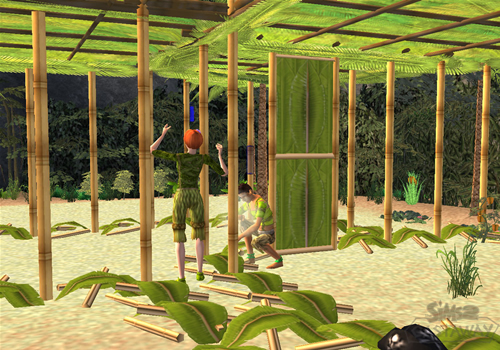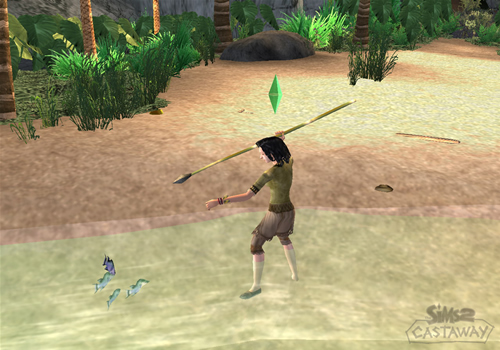The Sims 2: Castaway (Wii) Review
By Karn Spydar Lee Bianco  03.11.2007
03.11.2007
Castaway follows Pets as the second stand-alone console expansion for The Sims 2, which itself came to consoles towards the end of 2005. It, along with The Urbz and the original Sims outings, has a stronger focus on set objectives and goals as opposed to the near-total open-endedness of the PC originals. Nevertheless, there is plenty of content to sink your teeth into, so let’s get started! Read on for our full review.
Just in case the game’s name hasn’t given it away, the premise of Castaway is thus: you and a selection of up to five Sim companions are busy enjoying a relaxing cruise on your yacht when a storm appears, seemingly out of nowhere, and rips your fine vessel into pieces. You subsequently find yourself stranded on a tropical desert island with none of your sailing buddies in sight, and very few items on your person. And so begins your quest to make a life for yourself, find your friends, and eventually work your way back to civilisation.
You begin with the creation of between one and six Sims. The number you choose will have quite an impact on the rest of the game, so you’ll need to carefully consider whether you want to go it alone, which is arguably more difficult but often less frustrating (due to sporadic AI that means you often have to micro-manage certain aspects of other Sims on a regular basis), or bring an assortment of additional Sims with you to take some of the strain off. You can access the usual assortment of customisation options when you create a Sim, altering their personality, star sign, and appearance, but you must also choose a job for them. Examples include Mechanics, who have improved construction skills, and Chefs, who are well versed in the ways of creating tropical cuisine.

Regardless of the number of Sims you choose to create, you begin the game alone and with little more than a handy guidebook in your possession. There are a number of these guidebooks scattered throughout the game and they each contain a series of objectives for your Sim to accomplish. Additional guidebooks are unlocked as you complete a set number of objectives, or when you discover a new location on the map. Whilst it’s not essential to follow these guidebooks to the letter, you will often find that you are doing so, particularly in the early stages of the game, without intending to. That’s because the initial objectives are mostly simple in nature, for example collecting food to eat and resources to build a basic shelter with.
The game is controlled using a combination of the Wii remote and nunchuk. However, an early pop-up recommends that players should generally try to avoid pointing the former at the screen because doing so brings up a series of additional on-screen items such as bars representing your Sims needs. As a result, whilst having a pointer would seem like the perfect throwback to playing The Sims with a mouse, it isn’t used to particularly good effect at all. Instead, navigating most menus is largely done with a combination of nunchuk-tilting (extremely inaccurate) and by using the D-Pad. This wouldn’t be quite so irksome if the developers hadn’t included a number of sections that can only be accessed with the pointer, making for a very disjointed experience.
Alas, the in-game controls are also suitably flawed. Movement is achieved via the analogue stick and basic interactions/selections with the Z button. The problem is, to interact with anything your Sim must be standing nearby and facing in the correct direction, which can often get fiddly when there are multiple objects close together. Annoyingly, this could easily have been rectified if only the Wii remote pointer were usable to select in-game items and not just menu options. The issue is worsened by the fact that many objects (particularly people) have multiple interaction options, which can be equally difficult to select quickly, especially when using the nunchuk-tilt mentioned earlier. This often results in your fellow Sims wandering off in boredom, forcing you to chase after them and try the whole thing again.

Despite relying on such an awkward series of underlying mechanics, the game does have a lot to offer once you get going. Unlike the more-metropolitan Sims outings, Castaway obviously has no use for money, which means that items are valued according to the resources needed to create them. These include the likes of bamboo, brass, cotton, clay, wood, etc. As you begin the game you must collect each of these items manually by exploring one of the game’s three islands. More valuable/sophisticated resources will require you to build tools – such as knives, axes, etc – before you can collect them. These can be built using the first real creation in the game – the workbench, which starts life as a piece of driftwood placed on top of two rocks, but can eventually be upgraded into a stand-alone unit.
As you begin to progress into the game, discovering new locations and building new items, you will be introduced to more and more of your Sims needs. He/she starts with little more than a need for food and regular toilet-trips, but will eventually begin yearning for cleanliness, human (or other…) companionship, a place to call home, etc. Whilst it is possible to find yourself bogged down by such menial micro-management, some of it is quite enjoyable. For example, the need for companionship can either be solved by finding your crewmates or by befriending local chimps (who can eventually be trained to serve as your faithful monkey butlers!) or even by constructing a sand-person to commune with. Confronting hunger can be equally refreshing thanks to the extremely wide array of ingredients that can be found in the game. By mixing these together you can create some extremely satisfying meals, particularly as your cooking skills begin to improve and as you begin to build more advanced equipment.
Unfortunately, even with monkey butlers at your side (and your crew mates, who can be assigned jobs, such as cooking regular meals) you will still be spending a lot of time wandering around tapping Z every few seconds (whilst speeding up time with the C button) in order to collect as many resources as possible. Even with new areas to explore and animals to hunt therein, this can become quite tiresome, but it’s essential if you want to progress to new islands (which requires constructing water-vehicles) or if you want to improve your encampment, which is what we spent most of our time doing. It is extremely satisfying looking down on your perfectly-dry Sim sitting in a custom-made shack full of knick-knacks whilst a storm blares outside. Unfortunately, just when we found ourselves truly enjoying the Castaway experience, we came across a hitch; limited building space.

With each island segmented into separate areas, the locations available for construction are already fairly small in size, particularly because you cannot transform the terrain. But beyond that there are limits to the overall number of items/objects you can place in any one area without creating a ‘fire hazard‘. With no prior warning about such a limit we found ourselves cut-off from creating new objects before we got rid of some old ones. For a game with such a strong focus on open-ended gameplay and freedom, this feels like a major shortcoming, and it really hurts the game as a result. Whilst you can simply split your encampments over different areas, it’s not as satisfying. It’s also not at all convenient when you factor in the fairly intrusive loading times that hinder moving from one location to another.
Even after the crushing disappointment of not being able to realise our epic Swiss Family Robinson-esque island-paradise, we still found ourselves unable to leave the game alone. What with creating an extensive farm-area elsewhere on the island (complete with harvestable crops and chickens that lay eggs when you serenade them), not to mention the allure of hidden treasure and secret locations, extensive fashion-customisation options, crashed planes and boats to scavenge, and our vain attempts to get our only female crewmate to marry us (she keeps laughing at our proposals), it wasn’t long before we had invested many an hour into the game with the promise of lots more to come if we could find the time. If only the developers had sorted out some of the problems we’ve already mentioned, this could easily have been one of, if not the best Sims outings in years.

Cubed3 Rating
Very Good - Bronze Award

As far as Sims games go, Castaway is a refreshing change of pace that brings some truly unique and enjoyable ideas to the series. Whilst the overall experience is certainly flawed in many ways, if you can look past that (which does become easier with time, with the exception of building limitations) there is a lot of content and options tucked away for you to discover. If you’ve been looking for a decent Sims game for your home console, this could well be it.

![]() 7/10
7/10
![]() 8/10
(2 Votes)
8/10
(2 Votes)
 Out now
Out now  Out now
Out now  Out now
Out now  Out now
Out now Comments
Comments are currently disabled

 Sign In
Sign In Game Details
Game Details Subscribe to this topic
Subscribe to this topic Features
Features





 Top
Top

